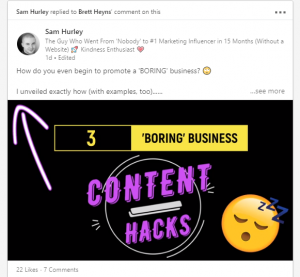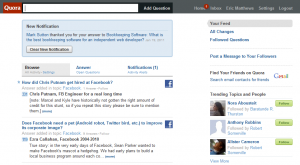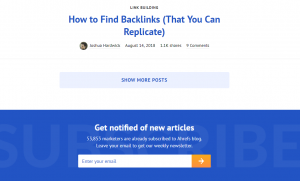The right content and tone of voice can help attract and convert tons of blog visitors into high-potential leads. Not convinced? Customers tend to associate with businesses who seem more trustworthy and less risky. That’s why athletes spend a $100 extra on Nike shoes instead of buying from local brands. There are many studies corroborating the fact that perceived trust and risk directly affect consumers’ purchase intent and purchase decisions. Effective business blogging can help you increase consumer trust and decrease perceived risk while collecting invaluable leads.
Here’s how.
8 business blogging best practices to turn your website visitors into leads
#1 Create addictive content
In an age where social media is a primary marketing channel, you have to create blog content that’s attention-worthy and addictive. Don’t succumb to boring block-text formats in the process of pleasing search engines. Remember that you’re subscribers and customers are human and wooing them is your actual goal.
How to create addictive content?
- Avoid overused topics with no new information. Don’t work on titles that you aren’t tempted to click on yourself. Outsource blog writing to an agency with crafty writers who can create such titles and content.
- Tell a story. Everyone loves stories. Use fresh anecdotes to explain concepts and images to stimulate imagination among your readers.
- Emulate trending content formats on social networks. For instance, this month, plenty of motivational speakers on Instagram used persuasive phrases and custom GIFs to make the Swipe-Up feature more compelling. You could apply the same idea to get readers to comment on your blogs. Effective communication is key. It’s hard to not swipe-up on Gary Vee’s Stories.
- Eliminate the fluff. If you’re using repetitive and empty words to fill space, cut them all out right away. In today’s age, you can go viral on a 3-word phrase and fail on a 3000-word long blog post all based on how attention-worthy your content is.
- Create a compelling hook. In today’s attention economy, what you say in the first 10 seconds of interaction with your reader matters. Make it exciting or expect to be ignored.
#2 Participate in key communities
You can’t build a community unless you have previously participated in one, and community building is a key part of lead generation. In fact, most top business bloggers in any industry are very likely also popular in that industry’s communities. Take Neil Patel for instance or Gary Vee. Neil Patel consistently shares video lessons on LinkedIn and Gary Vee advocates and practices active social media engagement. You have to constantly remind people that you’re worth engaging with, and it can’t only be on your blog.
What type of community participation boosts lead generation?
- Create a type of writing/communicating that defines you and actively use that voice in communities. For instance, Gary Vee cares and inspires. His USP is tough love, and he throws it in your face. That’s his identity. The key is to get people to remember you, visit you and want to give you their email ids, voluntarily.
- Identify active communities with your target audience. What’s the point of sharing content where no-one important will see it? Even if it takes you a week, search for communities that have super-active members who fit your target profile.
- Give away value for free. Your audience in these external communities needs to believe that you want to help and your help is worth paying for. Use a combination of the right words and giveaways to shape that perception of your brand in the eyes of your target audience. Here’s an example of what social media influencer Sam Hurley shares on his LinkedIn page.
#3 Answer pressing questions
Mark Robertson of ReelSEO claims that their #1 to grow readership is by answering readers queries, often publicly. So when a reader writes in asking a particular question, they convert the question into a blog topic and address it with useful ideas and solutions. By answering pressing questions, you can establish yourself as a trusted expert.
How to find and answer questions for your blog?
- Search for questions on forums such as Quora and Yahoo using industry keywords. Search the comments section of active blogs and social media posts. Refer to support queries sent in by your customers and requests sent in by your blog subscribers.
- Analyze bad experiences that your audience faces. Every bad experience that your target groups face and your product/service can solve makes for a good question. For instance, if your company retrieves data from old laptops and hard disks, you could write a post titled – How to Retrieve Lost Data?
- Feature industry experts answering questions. It doesn’t have to be you answering questions. You can collect answers from industry experts instead, by offering them exposure or a link back to their latest venture in exchange.
- Optimize your questions and answers for SEO. Intent-based SEO can drive you a ton of highly-convertible traffic. Use a keyword tool to identify search phrases that best suit your business and employ them in your question-answer blog posts.
#4 Optimize blog content for SEO
SEO can help you attract tons of website visitors to generate meaningful leads. Content-based SEO is probably the most efficient form of marketing because once you rank for a bunch of keywords, maintaining those positions is easy. Rank for a handful of phrases in your niche to ensure a constant flow of traffic from them over time.
How to optimize blog posts for search
- Focus on intent-based keyword phrases. What search phrases are your audience groups likely to use? List them and use them in your blog titles, subheads, and meta-descriptions to show up in search results more often.
- Identify low-competition keywords. Work with keywords that don’t have many direct search results on Google. These are typically easier to chase.
- Work in synonyms of keywords within your posts. By incorporating keyword synonyms in subheads and the body of your posts, you’re likely to strengthen the association between your content and target keywords on Google.
- Experiment with the Skyscraper Technique. Brian Dean and Backlinko have spoken extensively about the Skyscraper technique, using which you can target and overthrow blog posts ranking for any keyword.
#5 Get active on social networks
Social networks form an essential part of any content marketing plan. It doesn’t matter which industry your business lies in, if you’re not active on social media, you’re losing business to a competitor who is, as Gary Vee has rightly pointed out. There are ways for businesses of any kind to engage their audience on social networks. Here’s how you can market blog posts on social media to boost lead generation.
How to market your blog on social media
- Segment blog posts into multiple social media posts. Each blog post can be broken down into promotions for days, weeks or even months. All you need to do is simply turn subheads, points, and anecdotes into separate social media posts spread over a long interval of time. Every image on the blog post can also go out as a separate social media post.
- Include unconventional blog-promotion networks such as Pinterest and Instagram. Pin blog posts to Pinterest boards and share images on your blog post on Instagram. While links can’t be shared on Instagram, you can use Instagram Stories to talk about the post and instruct interested people to “view link in bio”.
- Save evergreen blog posts for reuse. Topics that can be used throughout the year can be saved on Google Sheets or in online libraries for reuse from time to time. Strategically reusing posts can also help with brand recall over time.
- Encourage and respond to comments creatively. Instead of responding to comments using text, you can reply using videos. You could also conduct a Facebook Live session to discuss the blog post on video, or convert the blog post into Slides or a video to make for a more engaging social media post.
#6 Optimize blog landing pages for conversions
It doesn’t matter if your content is amazing if your page isn’t designed to convert visitors. Many blogs suffer low lead generation rates because their font is a pain to read on mobile screens or their pop-up is extremely annoying. Ensure that your blog is well-designed, readable and conversion-friendly.
How to optimize blog landing pages for conversions
- Test pop-up and static lead collections form. There are top-performing blogs both with pop-up and static lead collection forms. It’s best for every blog to test which option converts more before sticking to one or the other.
- Optimize pop-up appearance time. The time when your lead collection pop-up box appears decides how many people interact with it. If the appearance is too premature it may irritate blog visitors, and if it’s too late, you may miss out on potential leads. Optimize time using a website analytics tool like SumoMe.
- Improve the readability of blog posts. The readability of your blog posts decides how long a blog visitor stays engaged and on your page. Use images such as graphs and GIFs to create text-breaks, and write short, clear and compelling sentences to catch the attention of blog visitors.
- Design a blog that’s easy to navigate. The time a blog visitor spends on your page affects SEO. If you design your blog well, people are likely to stay on it longer and interact with different elements on your pages. Check out, for instance, the Ahrefs blog – it’s a simple page with a list, subscription prompt, and a search bar.
#7 Offer irresistible benefits
Think lead magnets. What can you offer your audience in exchange for critical pieces of information? The goal of creating lead magnets is to optimize the number of leads collected in exchange for a piece of content. There’s no specific type of lead magnet that’s preferred or suggested, you can offer anything that your audience will find valuable.
What types of lead magnets to use
- Experiment with different types of lead magnets. Here are a few common types – eBooks, cheat sheets, whitepapers, guides, videos (prerecorded and webinars), reports and case studies.
- Work with topics not commonly covered on the internet. If what you’re offering is already available free on the internet, it’s probably not tempting enough to give up an email address for. Conduct a Google search before investing in creating a lead magnet.
- Consider placing multiple lead magnets on your blog. Don’t stop at one in one place. Chances are that your blog visitors are spread across multiple blog post pages. Why focus on one page when you could place a different lead magnet on pages focused on different topics? For instance, if there’s a page focused on “Lead generation techniques”, you could share a checklist of Lead Generation Hacks on the page.
- Optimize the pop-up or dialogue box offering the lead magnet. Apply the same rules you do to blog subscription forms to dialogue boxes that offer lead magnets. Ensure that they are A/B tested for design and when they appear.
#8 Collaborate with other bloggers
Over 4 million blog posts are published each day, according to Worldometer. That’s a large massive number of blogs competing for the limited attention of different target groups. When faced against this much opposition, it makes sense to partner with people who can help you increase exposure for your blog posts.
Whom to partner with on blog posts?
- Identify a list of other bloggers in your niche who don’t directly compete with you and are likely to be open to collaboration. Reach out to all of them with a proposal that benefits both you and them. Ensure that you have blogging goals in mind, so you have a definite direction for the collaboration.
- Invite influencers to participate in an interview series. Create an interview series and invite influencers to share their advice with your audience. This works well when your target audience is already following the influencers whom you collaborate with. Here’s an interview of Neal Schaffer, marketing influencer, conducted by Magda of Brand24.
- Feature current and potential customers on your blogs. The best way to build relationships with current and potential customers is to give them exposure and promote them on your blog and social media pages. You could even create case studies or success stories featuring customers, with permission.
Wrap
Small changes to your blog content and design can help turn website visitors into leads. Not convinces? Give these 8 business blogging best practices a try and measure your improved lead conversion rates with your previous ones.
Feature image via Freepik.com






